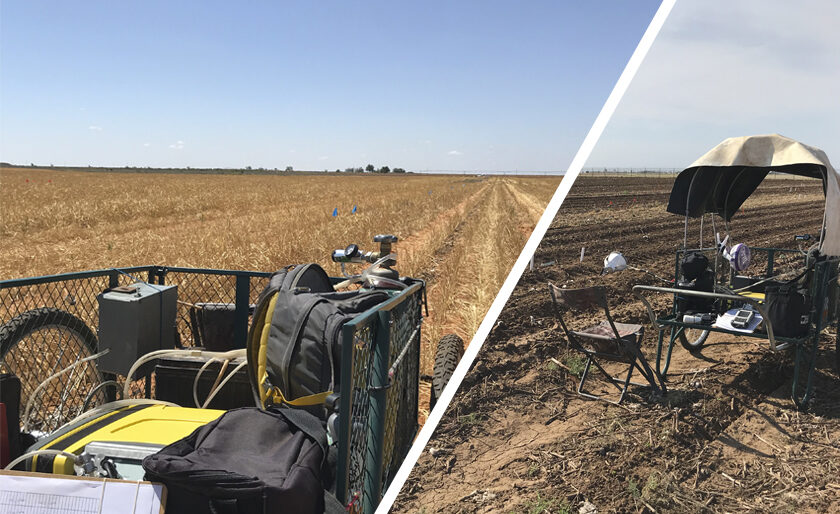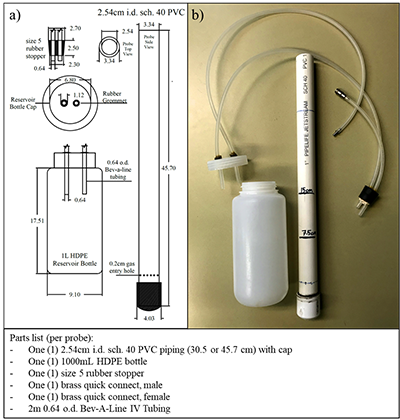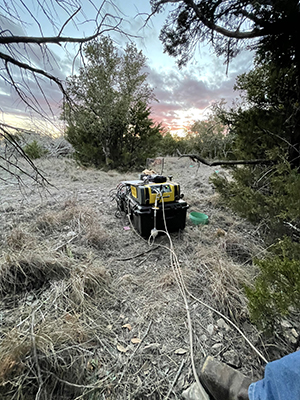
Developing an affordable pore space measurement system to assist agricultural research
Could measuring gases within the pore space of soil help identify conservation system and nitrogen fertilizer application practices that not only increase microbial activity and soil health, but also reduce greenhouse gas emissions from the soil surface? Mark McDonald from Texas A&M University and a team of researchers set out to answer these questions through their study.
In the first few years in a semi-arid agricultural system, greenhouse gas (GHG) emissions were determined to be affected by conservation system (CO2) and timing of nitrogen application (N2O). However, the observed production of CO2 and N2O, as well as the consumption of N2O, was not exclusively tied to the microbial community measurements conducted during this period.
What insights could the measurement of gas concentrations in soil spore spaces offer?
Pore space refers to that part of the soil volume which contains the liquid and gas phases of soil. Mainly, pore spaces facilitate the availability and movement of air or water within the soil environment.
Our study set out to consider if observing gases within the pore space would allow us to better relate the production of GHG to specific soil properties, identify conservation system and nitrogen fertilizer application timing combinations that increase microbial activity and soil health, and reduce GHG emissions from the soil surface.
What were the main objectives of the research?
- Develop an affordable pore space measurement system that would use the sampling equipment that we already had — Gasmet DX4040 (predecessor to the GT5000 Terra)
- Evaluate pore space concentrations from semi-arid agricultural systems under different soil management regimes
- Determine the relationship between pore space concentrations and soil biochemical properties that are commonly measured in agricultural soil science.
What kind of pore space flux instrumentation was used to conduct the research?
Our literature review of potential methods for measuring pore space concentrations of gases revealed a few key factors. Pore space measurements are not often conducted in agricultural systems which was likely due to measurement apparatuses being costly and needing field disturbance to implement.
Dr Martin Brummel and Dr Steve Siciliano had already developed a framework for pore space sampling using a Gasmet analyzer. Their probe design had several advantages including far less disturbance to the field using small guide holes for probe installation vs. trenching for semi-permeable tubes (the next best option for agricultural systems) which would prove to be cost-prohibitive and time-consuming.
The probe concept has a small footprint, and we only need to add additional chambers 24 hours in advance of sampling. This meant the design was ideal for agricultural research projects where it is a high priority to be able to conduct field operations with minimal equipment removal and without worrying about destroying costly research equipment.
However, their design included steel probes and several probes per sampling area which could prove costly for larger-scale agricultural research studies. The strength of steel probes could also damage field equipment.
How was the design of the probe modified to fit into the requirements and limitations of the study?
Our modification of the probe design by Brummel and Siciliano hinged on two key factors: cost-effectiveness and ease of installation/removal.
We zeroed in on schedule 40 PVC piping as the material for our probes due to its general lack of reactivity with GHG and its tolerance to heat fluctuations which are common in semi-arid soils. The material is cheap and easily available at local piping and hardware stores, which means our modified probes could be produced by anyone with a hacksaw, pipe glue, and some elbow grease.
We used heat-tolerant and non-reactive Bev A-line tubing which is the same material used to connect the Gasmet analyzer to the sampling chamber for surface measurements. HDPE bottles were used as our reservoirs, and rubber grommets + weatherproof silicone ensured adequate sealing.
The last key component was quick-connect tubing connectors which were purchased from an online retailer specializing in hose connections for half the cost of each probe.

Figure 1 a) schematic drawing of pore space probe (PSP) and reservoir bottle, all dimensions in cm. b) Image of constructed PSP and reservoir bottle. Published by McDonald et al. in Soil Security, September 2021.
Guide holes were created using a soil sampling hand-probe, probes were hammered to the desired depth, the annular space around the probe was backfilled, and probes were allowed to settle for at least 7 days before measurement. The day before sampling the reservoir bottle system (pictured in Figure 1) was attached to the probe to increase the volume of the probe system which eliminated the potential for a vacuum to be placed on the soil pores and thus the preferential flow of gases from larger pores.
On the day of sampling, the Gasmet analyzer was deployed in the field and integrated into each probe in a closed-loop system for sampling over a three-minute period. Sampling through the field was conducted in a similar manner to soil-surface measurements, with overall sampling times of 8-12 hours for the entire field (36-45 plots).
How did Gasmet analyzer support your research?
Future research into the microbial mechanisms driving gas production in agricultural systems should strongly consider measuring pore space concentrations as they are more sensitive to changes in biology than surface-emission measurements.
Our probe design was developed to utilize the Gasmet analyzer we were already deploying for surface measurements, which is definitely our choice for analyzer technology due to its ability to simultaneously measure so many greenhouse gases.
We also value the technical support Gasmet has provided over the last several years of research. When a few issues arose due to unforeseen field circumstances, Gasmet support helped us resolve them and conduct timely measurements in the field.
What were the results of the study?
We determined that soil pore space gas concentrations were more strongly correlated to the abundance of denitrification genes compared to the relationship between surface emissions and denitrification gene abundance (manuscript in preparation). This supported our hypothesis that pore space measurement results is more relevant information regarding the relationship between GHG production and soil biology.
We also determined a less robust relationship between pore space concentration and the timing of nitrogen fertilizer application than between surface emissions and fertilizer timing. The same general patterns were observed with greater emissions/concentrations following the application of fertilizer, but the significance of the pattern was reduced, and it was determined that there was a larger base level of nitrogen gases present than was expected.
Overall, it is promising that our pore space probe design modification provided additional relevant information to understand the relationships between greenhouse gas production, soil microbial characteristics, and common farming practices on the Texas Southern High Plains.
*Information on the installation of the probes and sampling information can be found in our method publication titled “Soil pore-space gas probes for use in agricultural research” published in Soil Security in September 2021.
| Greenhouse gas flux measurements
The measurement of GHGs from soil represents an important part of climate change research. GHGs, such as Carbon Dioxide (CO2), Methane (CH4) and Nitrous Oxide (N2O), released from soils into the atmosphere are primarily biogenic by origin. Learn more about our solutions for measuring greenhouse gases from soil |
 |